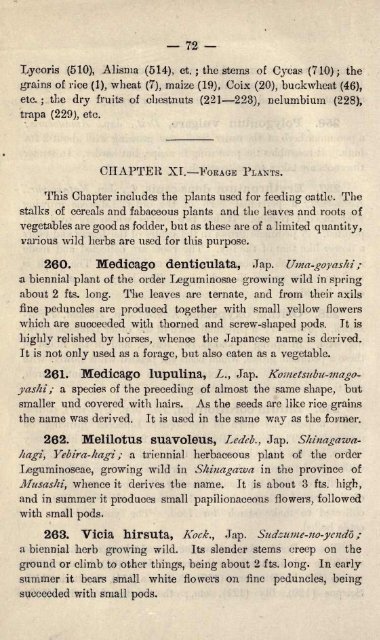Untitled - University of Oregon
Untitled - University of Oregon
Untitled - University of Oregon
You also want an ePaper? Increase the reach of your titles
YUMPU automatically turns print PDFs into web optimized ePapers that Google loves.
Lycoris (510), Alisma (514), et. ; the stems <strong>of</strong> Cycas (710); the<br />
grains <strong>of</strong> rice (1), wheat (7), maize (19), Coix (20), buckwheat (46),<br />
etc.; the dry fruits <strong>of</strong> chestnuts (221 223), nelumbium (228),<br />
trapa (229), etc.<br />
CHAPTER XI. FORAGE PLANTS.<br />
This Chapter includes the plants used for feeding cattle. The<br />
stalks <strong>of</strong> cereals and fabaceous plants and the leaves and roots <strong>of</strong><br />
vegetables are good as fodder, but as these are <strong>of</strong> a limited quantity,<br />
various wild herbs are used for this purpose.<br />
260. Medicago denticulata, Jap. Uma-goyashi;<br />
a biennial plant <strong>of</strong> the order Leguminosae growing wild in spring<br />
about 2 fts. long. The leaves are ternate, and from their axils<br />
fine peduncles are produced together with small yellow flowers<br />
which are succeeded with thorned and screw-shaped pods. It is<br />
highly relished by horses, whence the Japanese name is derived.<br />
It is not only used as a forage, but also eaten as a vegetable.<br />
261. Medicago lupulina, L., Jap. Kometsubu-magoyashi<br />
; a species <strong>of</strong> the preceding <strong>of</strong> almost the same shape, but<br />
smaller und covered with hairs. As the seeds are like rice grains<br />
the name was derived. It is used in the same way as the foi.-rner.<br />
262. MelilotUS suavoleus, Ledeb., Jap. Shinagawahagi,<br />
Yebira-hagi ; a triennial herbaceous plant <strong>of</strong> the order<br />
Leguminoseae, growing wild in Shinagaiva in the province <strong>of</strong><br />
M^tsas/l^, whence it derives tbe name. It is about 3 fts. high,<br />
and in summer it produces small papilionaceous flowers, followed<br />
with small pods.<br />
263. Vicia hirsuta, Kock., Jap. Sudzume-no-yendo ;<br />
a biennial herb growing wild. Its slender stems creep on the<br />
ground or climb to other things, being about 2 fts. long. In early<br />
summer it bears small white flowers on fine peduncles, being<br />
succeeded with small pods.

















